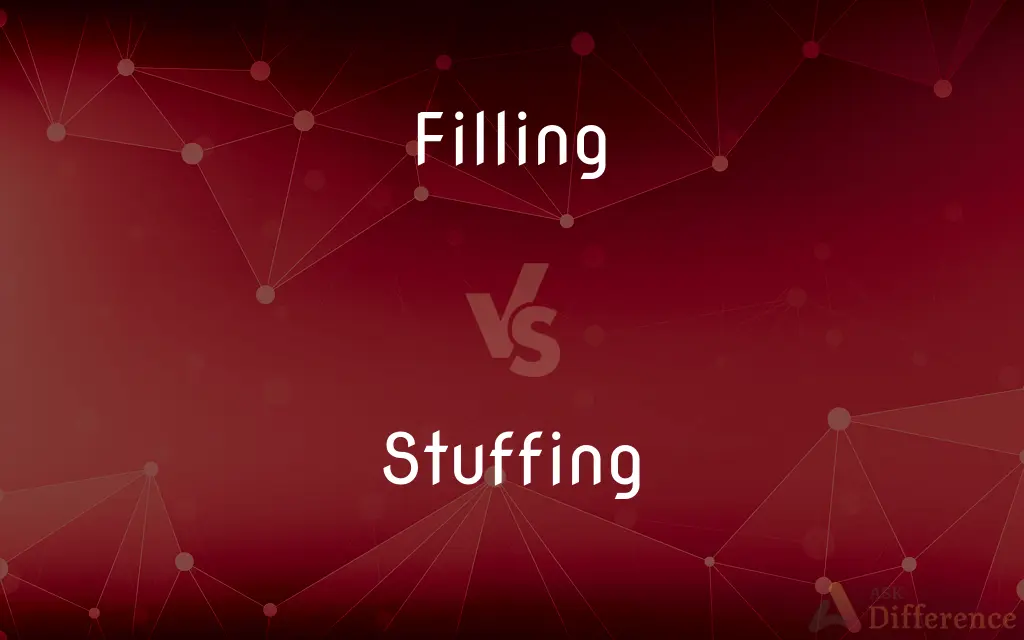Filling vs. Stuffing — What's the Difference?
By Tayyaba Rehman & Fiza Rafique — Updated on April 6, 2024
Filling is a mixture used inside food items, often more integrated, while stuffing is a denser mixture placed inside cavities, primarily in poultry.

Difference Between Filling and Stuffing
Table of Contents
ADVERTISEMENT
Key Differences
Filling is a broad term that refers to any mixture used to add flavor or texture inside another food item, such as pastries, pies, or dumplings. It can range from sweet to savory and is designed to complement the outer layer of the food it fills. Stuffing, on the other hand, is traditionally a seasoned bread mixture used to fill the cavity of poultry or meat before cooking, though it can also refer to mixtures used in vegetables. While both enhance the main dish, stuffing is particularly associated with giving structure and absorbing flavors from the meat during roasting.
Fillings are often softer or more fluid and are crucial in defining the dish’s overall flavor profile, such as custards in pastries or cheese in ravioli. Whereas stuffing, being denser and often bread-based, aims to retain its texture even after absorbing juices from the meat, contributing a distinct texture contrast to the dish. The preparation of fillings usually involves mixing to a smooth or finely textured consistency, suitable for easy integration with the main food item. In contrast, stuffing preparation might include cubing or tearing bread, chopping vegetables, and combining them with seasonings and sometimes broth or butter for moisture, resulting in a coarser texture.
While fillings serve to enhance or complement the flavor of the main ingredient, such as fruit filling in a pie, stuffings are often enjoyed as a side dish alongside the main course, especially in traditional feasts like Thanksgiving. This distinction underscores the stuffing's dual role in both enhancing the main dish's flavor and serving as an independent component of the meal. Moreover, fillings can be used in a wide range of culinary applications, from sweet desserts to savory snacks, making them versatile in the culinary world. Stuffing, with its strong associations with holiday meals and specific dishes like stuffed turkey or chicken, has a more defined culinary role.
In addition, the cultural context of using fillings versus stuffing varies widely. Fillings reflect a global culinary practice, found in diverse cuisines around the world in forms like dumplings, pastries, and sushi. Stuffing, while also present in various cultures, is heavily associated with Western cuisine, particularly as part of holiday meals like Thanksgiving and Christmas in the United States and Canada, where it has a significant traditional and emotional significance.
Comparison Chart
Composition
Can be sweet or savory; often soft or fluid.
Primarily savory; denser, often bread-based.
ADVERTISEMENT
Purpose
Enhances or complements the main ingredient.
Gives structure, absorbs meat juices, can be a side dish.
Texture
Integrated smoothly with the main food item.
Retains a coarser texture, contrast to main dish.
Culinary Role
Versatile, used in desserts to savory dishes.
Associated with specific dishes, notably poultry.
Cultural Significance
Found in diverse cuisines worldwide.
Strongly linked to Western holiday traditions.
Compare with Definitions
Filling
A mixture placed inside food items to add flavor or texture, often smoother in consistency.
The cherry filling in the pie was both tart and sweet.
Stuffing
A seasoned bread mixture used to fill the cavity of poultry or meat.
The turkey was stuffed with a savory mixture of bread, herbs, and celery.
Filling
Integral to the dish, complementing the outer components.
The custard filling in the éclairs was creamy and vanilla-flavored.
Stuffing
Often denser and designed to absorb juices from the meat during cooking.
The stuffing inside the chicken was moist and flavorful.
Filling
Used in both sweet and savory dishes, such as pastries or stuffed pasta.
The ravioli had a rich cheese filling.
Stuffing
Can also be used to stuff vegetables or as a standalone side dish.
Stuffed bell peppers made with a hearty bread and beef stuffing.
Filling
Can vary widely in ingredients, from meats to fruits or cheeses.
The dumplings had a savory pork and cabbage filling.
Stuffing
Associated with traditional feasts and holiday meals.
For Thanksgiving, the stuffing is a must-have side dish.
Filling
Reflects global culinary practices with diverse applications.
The sushi rolls were made with a filling of fresh vegetables and rice.
Stuffing
Preparation involves combining bread with vegetables, seasonings, and sometimes liquids.
The stuffing was prepared with cubes of stale bread, onion, sage, and chicken broth.
Filling
A quantity of soft material that fills or is used to fill something
Duvets with synthetic fillings
Stuffing
Stuffing, filling, or dressing is an edible mixture, often composed of herbs and a starch such as bread, used to fill a cavity in the preparation of another food item. Many foods may be stuffed, including poultry, seafood, and vegetables.
Filling
(of food) leaving one with a pleasantly satiated feeling
The full English breakfast was delicious and also very filling
Stuffing
A mixture used to stuff poultry or meat before cooking
Packet stuffings are quick to use
Sage and onion stuffing
Filling
An act or instance of filling.
Stuffing
Padding used to stuff cushions, furniture, or soft toys
The stuffing is coming out of the armchair
Filling
Something used to fill a space, cavity, or container
A gold filling in a tooth.
Stuffing
A heavy defeat in sport.
Filling
An edible mixture used to fill pastries, sandwiches, or cakes. See Note at frosting.
Stuffing
Padding put in cushions and upholstered furniture.
Filling
The horizontal threads that cross the warp in weaving; weft.
Stuffing
Food put into the cavity of a piece of meat or a vegetable that has been hollowed out.
Filling
Present participle of fill
Stuffing
Present participle of stuff
Filling
Of food, that satisfies the appetite by filling the stomach.
A filling meal
Stuffing
The matter used to stuff hollow objects such as pillows and saddles.
The stuffing is made of synthetic goose down.
Filling
Anything that is used to fill something.
Stuffing
Any of many food items used to stuff another.
Stuffing for a Christmas turkey
Filling
The contents of a pie, etc.
Stuffing
A mixture of oil and tallow used in softening and dressing leather.
Filling
(dentistry) Any material used to fill a cavity in a tooth or the result of using such material.
I will be using a rapid-setting cement filling.
My temporary filling fell out and got lost.
Stuffing
Severe defeat
United were given an absolute stuffing by City.
Filling
The woof in woven fabrics.
Stuffing
(internet) The insertion of many copies of a word into a web page in an attempt to increase its search engine ranking.
Filling
Prepared wort added to ale to cleanse it.
Stuffing
A tax loophole whereby a corporation acquires property that will result in a loss of revenue, purely in order to reduce its tax liability.
Filling
(Protestantism) A religious experience attributed to the Holy Ghost "filling" a believer.
Stuffing
That which is used for filling anything; as, the stuffing of a saddle or cushion.
Filling
That which is used to fill a cavity or any empty space, or to supply a deficiency; as, filling for a cavity in a tooth, a depression in a roadbed, the space between exterior and interior walls of masonry, the pores of open-grained wood, the space between the outer and inner planks of a vessel, etc.
Stuffing
Any seasoning preparation used to stuff meat; especially, a composition of bread, condiments, spices, etc.; forcemeat; dressing.
Filling
The woof in woven fabrics.
Stuffing
A mixture of oil and tallow used in softening and dressing leather.
Filling
Prepared wort added to ale to cleanse it.
Stuffing
A mixture of seasoned ingredients used to stuff meats and vegetables
Filling
Any material that fills a space or container;
There was not enough fill for the trench
Stuffing
Padding put in mattresses and cushions and upholstered furniture
Filling
Flow into something (as a container)
Filling
(dentistry) a dental appliance consisting of any of various substances (as metal or plastic) inserted into a prepared cavity in a tooth;
When he yawned I could see the gold fillings in his teeth
An informal British term for `filling' is `stopping'
Filling
A food mixture used to fill pastry or sandwiches etc.
Filling
The yarn woven across the warp yarn in weaving
Filling
The act of filling something
Common Curiosities
Can fillings and stuffings be made vegetarian or vegan?
Yes, both can be adapted to vegetarian or vegan recipes using plant-based ingredients.
Are there sweet versions of stuffing?
While less common, sweet versions of stuffing exist, often used in desserts like stuffed baked apples.
How do you choose between using a filling or stuffing for a dish?
The choice depends on the dish's desired texture and how the flavor should be integrated with the main ingredient.
What is the main difference between filling and stuffing?
The main difference lies in their texture and usage: filling is often softer and more integrated with the main food, while stuffing is denser, used in cavities of meats or vegetables, and can serve as a side dish.
How does the preparation of filling and stuffing differ?
Filling preparation often involves blending to a smooth consistency, while stuffing preparation involves combining coarser ingredients for texture.
Why is stuffing associated with holiday meals?
Stuffing has a long tradition as part of festive meals, adding a rich, savory component that complements the main dish, especially in Western cultures.
Can stuffing be eaten on its own?
Yes, stuffing can be cooked separately and enjoyed as a standalone side dish.
Is it possible to use the same mixture for both filling and stuffing?
While possible, modifications may be needed to adjust texture and moisture content appropriate for each application.
Can fillings or stuffings be prepared in advance?
Yes, many can be prepared in advance and stored properly until needed, though some may require last-minute assembly or cooking.
What are some common fillings for pastries?
Fruit preserves, custard, and sweetened cheese are common pastry fillings.
Share Your Discovery

Previous Comparison
Earth vs. World
Next Comparison
Hereof vs. WhereofAuthor Spotlight
Written by
Tayyaba RehmanTayyaba Rehman is a distinguished writer, currently serving as a primary contributor to askdifference.com. As a researcher in semantics and etymology, Tayyaba's passion for the complexity of languages and their distinctions has found a perfect home on the platform. Tayyaba delves into the intricacies of language, distinguishing between commonly confused words and phrases, thereby providing clarity for readers worldwide.
Co-written by
Fiza RafiqueFiza Rafique is a skilled content writer at AskDifference.com, where she meticulously refines and enhances written pieces. Drawing from her vast editorial expertise, Fiza ensures clarity, accuracy, and precision in every article. Passionate about language, she continually seeks to elevate the quality of content for readers worldwide.














































